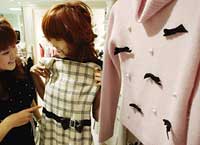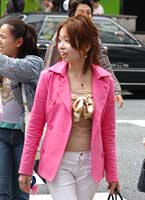|
|
|||||||
|
|
|||||||
|
|||||||
| | Web Japan >> | Trends in Japan >> | Fashion >> | A Ribbon Runs Through It | |
|
A RIBBON RUNS THROUGH IT The Fashion World's Insatiable Appetite for Japanese Ribbon (June 1, 2005) Fashions of the past few seasons have been marked by a natural look with an emphasis on femininity and cuteness, and high-quality ribbon made in Japan has been at the heart of this trend. Last year's fall/winter collections in Paris and Milan featured a return to classic styles, with prim-and-proper ribbons appearing in abundance. And many spring/summer 2005 collections used ribbons to accentuate their cute styles. Ribbons are being worn around the waist like belts; are decorating hemlines; and are being used as trim to add a touch of softness to the trench coats that are currently so popular. What many people may not know is that Japanese manufacturers lead the world in the production of the high-quality ribbon used by the global fashion industry. An Industry with Deep Historical Roots Over 90% of the ribbon made in Japan comes from a single region, Fukui Prefecture, which is located near the ancient city of Kyoto. The prefecture's origins as a ribbon manufacturing center lie in the Meiji period (1868-1912). Kyoto had long been a hub of technology for the production of woven articles, such as obi sashes. Early in the Meiji period, many artisans from Fukui who had been studying weaving in Kyoto brought their craft back to their home region. And thus Fukui began a journey that was to put it firmly on the map as a textile production center. In the late Meiji period, artisans began making ribbons for adorning kimono collars and hems, as well as hats, and these adornments soon caught on. Japanese ribbon owes its exceptional quality to the refined weaving technology that is rooted in the tradition of kimono. Ribbons in Art The story of Japanese ribbon's rise to global prominence reflects the country's long-standing expertise in adopting cultural expressions from elsewhere and imbuing them with influences from Japan's own cultural traditions. The early pioneers of the Japanese ribbon industry succeeded in giving their ribbon fresh, unique qualities. The fashion world's enthusiasm for Japanese ribbon shows no sign of reaching the end of its spool just yet. Copyright (c) 2005 Web Japan. Edited by Japan Echo Inc. based on domestic Japanese news sources. Articles presented here are offered for reference purposes and do not necessarily represent the policy or views of the Japanese Government. |
LACE AND FRILLS (June 5, 2002) |
|
|





